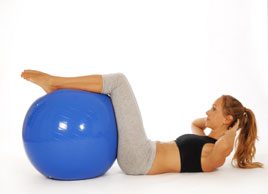Pilates: How to get started
Developed for dancers but made popular in mainstream gyms, Pilates exercise helps you limber up your entire body as you also strengthen and flatten your abdominal muscles

Source: Web exclusive, July 2011
Pilates for beginners?
There’s a misconception that you have to be an uber-fit celebrity, athlete or dancer to even consider entering a Pilates studio. Truth is, you don’t need any previous exercise experience to test the waters with Pilates.
"Pilates is an excellent entry-level fitness class because it starts out quite slowly," says Leanne Zdebiak-Eni, a certified Pilates instructor and owner of Island Pilates & Fitness in Courtenay, B.C. “Intensity gradually increases as you gain mind-body awareness and core strength. Plus, there are many possible modifications to suit everyone from average exercisers to high-level athletes.”
Just avoid filling up your entire workout schedule with Pilates classes. It’s not a form of cardio exercise, so it doesn’t do much to strengthen your heart and lungs compared to brisk walking or cycling.
“Most Pilates classes focus on working the deep core and improving flexibility,” says Zdebiak-Eni. Many Pilates exercises are performed lying down. Round out your routine with cardio and lifting weights to tone your arms, chest, back and legs, too.
Pilates mat or machine?
The nice thing about Pilates is that you can do it virtually anywhere using just a mat. But you can also do it on a special Pilates apparatus called a Reformer. Which is best for beginners? "I don’t think there’s a right or wrong answer on this one," says Zdebiak-Eni.
If you have both formats at your disposal, sometimes using the Reformer can help you feel or understand an exercise better than the mat can, explains Zdebiak-Eni. However, your own body weight and small pieces of Pilates equipment‘such as a toning ball and band’are often all you need, especially since not all gyms and studios offer Reformer machines.
Budget may also be a consideration. "Mat classes are usually a more economical way to reap the benefits of Pilates," says Zdebiak-Eni.
Getting Pilates breathing right
If you’ve already tried a Pilates workout, you might have noticed the instructor telling you to inhale and exhale at specific times during an exercise. What’s that about?
“The breath aids in focusing the mind, oxygenating the blood, activating deep core muscles and relaxing muscles through the neck and shoulders,” says Zdebiak-Eni.
The breathing patterns can take some getting used to. "I tell my new participants to just breathe! Don’t worry so much about when to inhale or exhale at first," says Zdebiak-Eni. "Breathing is an extremely important and specific part of every Pilates exercise’it takes time to really master."
What to wear to Pilates
Since the Pilates discipline is so focused on core strength and stability, wear clothing that is fairly fitted and not too loose in the torso region, if you’re comfortable doing so, says Zdebiak-Eni. That helps the instructor provide guidance and cues about your technique. Most yoga attire works well; and, like yoga, Pilates is done barefoot.
Your first Pilates class
"My students always find the first class or two a bit overwhelming because there is a lot of information to learn when you’re just starting," says Zdebiak-Eni. “It’s important to remember that Pilates is like teaching your body a brand-new language. It’s going to take time to grasp it, but it’s worth the time and effort.”
Don’t miss out! Sign up for our free weekly newsletters and get nutritious recipes, healthy weight-loss tips, easy ways to stay in shape and all the health news you need, delivered straight to your inbox.




